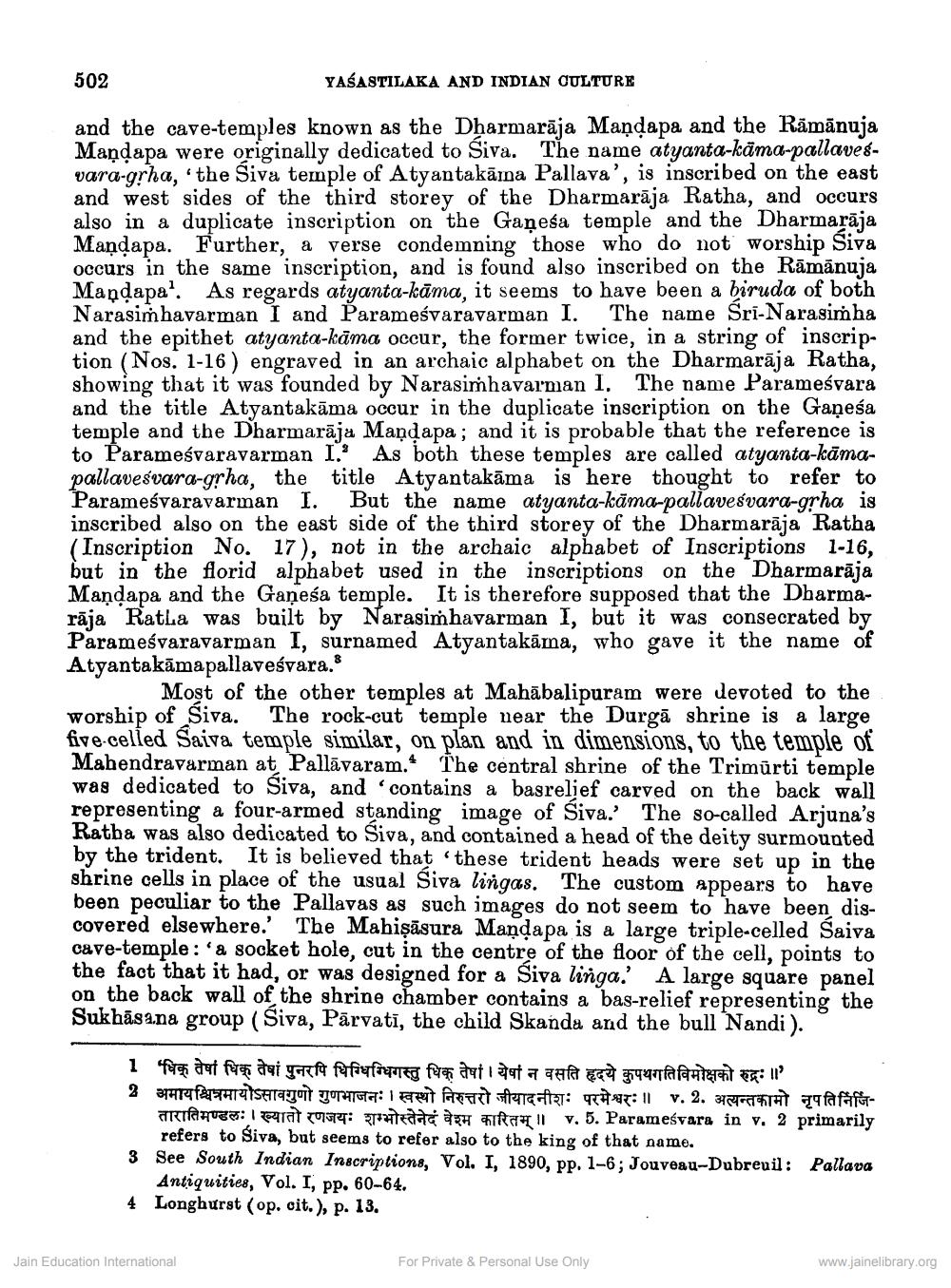________________
502
YAŠASTILAKA AND INDIAN CULTURE
and the cave-temples known as the Dharmarāja Mandapa and the Rāmānuja Mandapa were originally dedicated to Siva. The name atyanta-kama-pallavesvara-grha, the Siva temple of Atyantakāma Pallava', is inscribed on the east and west sides of the third storey of the Dharmarāja Ratha, and occurs also in a duplicate inscription on the Ganesa temple and the Dharmarāja Mandapa. Further, a verse condemning those who do not worship Siva occurs in the same inscription, and is found also inscribed on the Rāmānuja Mandapa?. As regards atyanta-kāma, it seems to have been a biruda of both Narasimhavarman I and Parameśvaravarman I. The name Sri-Narasimha and the epithet atyanto-kāma occur, the former twice, in a string of inscription (Nos. 1-16 ) engraved in an archaic alphabet on the Dharmarāja Ratha, showing that it was founded by Narasimhavarman I. The name Parameśvara and the title Atyantakāma occur in the duplicate inscription on the Ganesa temple and the Dharmarāja Mandapa; and it is probable that the reference is to Parameśvaravarman 1. As both these temples are called atyanta-kāmapallavesvara-grha, the title Atyantakāma is here thought to refer to Parameśvaravarman 1. But the name atyanta-kāma-pallavesvara-grha is inscribed also on the east side of the third storey of the Dharmarāja Ratha (Inscription No. 17), not in the archaic alphabet of Inscriptions 1-16, but in the florid alphabet used in the inscriptions on the Dharmarāja Maņdapa and the Ganesa temple. It is therefore supposed that the Dharmarāja Ratha was built by Narasimhavarman I, but it was consecrated by Parameśvaravarman I, surnamed Atyantakāma, who gave it the name of
Atyantakāmanallah,, surnamed Atsarman I, but it w
Most of the other temples at Mahābalipuram were devoted to the worship of Siva. The rock-cut temple near the Durgā shrine is a large five-celled Saiva temple similar, on plan and in dimensions, to the temple of Mahendravarman at Pallāvaram.* The central shrine of the Trimurti temple was dedicated to Siva, and contains a basrelief carved on the back wall representing a four-armed standing image of Siva.' The so-called Arjuna's Ratba was also dedicated to Siva, and contained a head of the deity surmounted by the trident. It is believed that these trident heads were set up in the shrine cells in place of the usual Siva lingas. The custom appears to have been peculiar to the Pallavas as such images do not seem to have been discovered elsewhere. The Mahişāsura Maņdapa is a large triple-celled Saiva cave-temple : 'a socket hole, cut in the centre of the floor of the cell, points to the fact that it had, or was designed for a Siva linga. A large square panel on the back wall of the shrine chamber contains a bas-relief representing the Sukhāsa.na group (Siva, Pärvati, the child Skanda and the bull Nandi).
1 "धिक् तेषां धिक् तेषां पुनरपि थिग्धिग्धिगस्तु धिक तेषां । येषां न वसति हृदये कुपथगतिविमोक्षको रुद्रः॥' 2 अमायश्चित्रमायोऽसावगुणो गुणभाजनः । स्वस्थो निरुत्तरो जीयादनीशः परमेश्वरः॥ v. 2. अत्यन्तकामो नृपतिनिजि
arches: llat 97814: T ag az all v. 5. Parameśvara in v. 2 primarily
refers to Siva, but seems to refer also to the king of that name. 3 See South Indian Inscriptions, vol. I, 1890, pp. 1-6; Jouveau-Dubreuil : Pallava
Antiquities, Vol. I, pp. 60-64. 4 Longhurst (op. cit.), p. 13.
Jain Education International
For Private & Personal Use Only
www.jainelibrary.org




